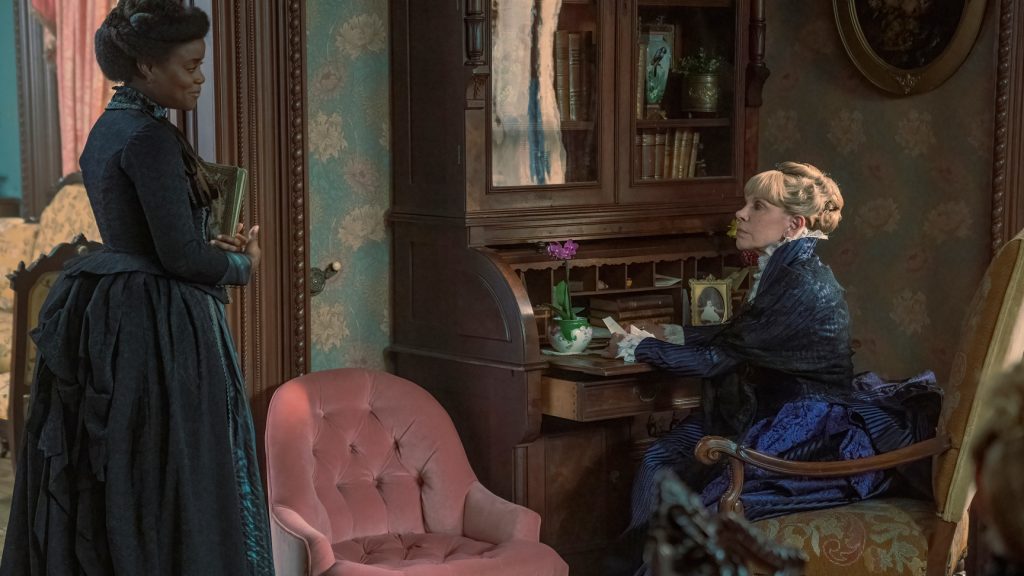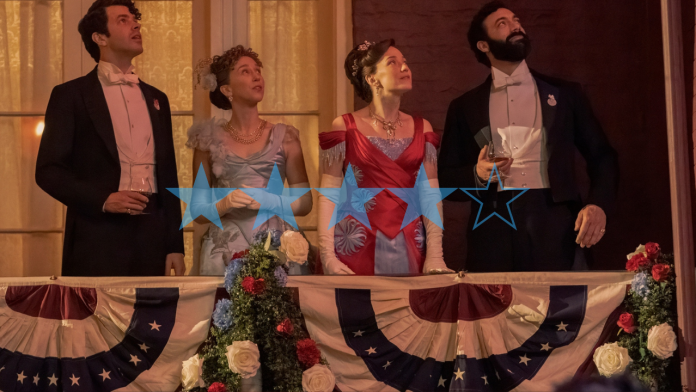For something to be seen as ‘gilded’, The Cambridge Dictionary cites it must be covered with a thin layer of gold. With such a definition in mind, HBO’s The Gilded Age is a double whammy in both its telling of a defining American era as well as being pedigree, truly golden, television.
Written and developed by Julian Fellowes, creator of Downton Abbey (2010-15), the series focuses on 1880s New York society and the families that struggle for power in a rapidly developing world. Whilst season one focused largely on the complex integration of Marian Brook (Louisa Jacobson) and Bertha Russell (Carrie Coon) into Manhattan, the second season takes further steps in developing your love for the characters whose heart and soul really allow this high concept (and even higher budget) period-drama to flourish in its sophomore run.
Opening the second season with juxtaposing Easter Sunday services, The Gilded Age immediately jumped into what it does best, providing fantasy and entertainment amidst historical realism. The black congregation, represented by Peggy Scott (Denée Benton), are shown at a humble yet vivacious ceremony in Philadelphia whilst the white, upper-class characters follow suit at a status-heavy session held on the Upper East Side of Manhattan. The swift and energetic edits between locations provide us with a fresh reminder of each character’s position in the chess game that is New York society, whilst maintaining a sense of mystery surrounding what could have happened in the year that has passed.
In echoing back to what makes The Gilded Age so brilliant, albeit different from its spiritual companion Downton Abbey, is Fellowes’ commitment to providing entertainment above all else. With the stiff upper lip of Britain not being of concern for writer Fellowes, the American setting allows for a more nuanced and casual approach to production and an embracing of the tackier elements that would make Dame Maggie Smith’s Violet Crawley sneer. Even in the home of the Rhijn-Brook family, the more conservative individuals portrayed by Cynthia Nixon and Christine Baranski, the costume remains pantomime-esque and regal. Further, and similarly to Downton, Fellowes’s attention to the lives of the staff allows for a more accurate and less rose-tinted view of a time period that notoriously favoured the upper class.
As the second season progressed, it became clear that Fellowes had made the decision to truly lean into the more melodramatic and saccharine elements that made the first season such a hit with audiences, but a disaster with certain critics. “All of human life is here. Not in any credible way – just here” wrote Lucy Mangen of The Guardian upon the season one premiere, citing what also became a reasonably credible criticism in that there were too many characters, too many nails being hit on the head, to invest in any one particular story arc. Whilst the prior establishing of these too many characters doesn’t exactly allow for their erasure this time around, there is a notable shift from episodic issues surrounding individuals to more overall plotlines that allow for the tension to build. The most obvious and best example of this is Bertha Russell’s (Carrie Coon) continued climb of the social ladder. With the first season seeing her struggle to establish her footing amongst the ‘old money’, season two sees her utilising the new Metropolitan Opera House to her advantage and gaining a legion of new devotees using her husband’s dirty railway money. Speaking of the railway, Morgan Spector does some brilliant old-timey bellowing and finger-pointing as robber baron George Russell, representing the political issues of the period as his railway workers unionise and fight for their right to a healthy work-life balance.
The opulent wealth that gave the time period and series its name is also expanded on alongside the historical inequalities that got the Russell family where they are. Each and every single one of Bertha’s dresses are more complex and more beautiful than the next. In terms of the modern elements of the costume that pull the series away from its period setting and into the modern world, Carrie Coon explained via her Instagram that “we’re accustomed to seeing these period pieces now and so we have to actually cater a little bit to the modern eye … and make sure that the costumes still do what they were doing then to us now”. This elevation of the style from the first season further establishes Fellowes’ leaning into the entertaining elements of the series and allows for the viewer to be truly sucked into this world whilst still understanding its aesthetic significance using modern context.

But with all this in mind, all the technical, narrative and soapy flair being noted, Fellowes finds his biggest success in his utilisation of the series’ best performer, the aforementioned Cynthia Nixon. A far cry from her most famous role as Miranda Hobbes in HBO’s flagship Sex and the City (1998-2004), Nixon’s depiction of the wise and soft Ada Brook brings a certain humanity to a series that dedicates much of its runtime to the cold and cutting Manhattan social scene. Whilst Ada was largely used as a foil to her sharp-tongued sister Agnes in the first season, the second finds her finally getting what she deserves: a love and life of her own. With this plotline, the more romance-inclined viewer can find comfort in Ada and pastor Luke’s late-in-life romance that the two portray so youthfully, even if it is marred by tragedy. To describe this story arc as anything short of a fairy tale would be a disservice, and the predictability of it, akin to a fairy tale, only allows for the viewer to relish even further.
As the second season drew to a close and the seeds were sown for a third round, myself and yes, my mother, kept an eager eye on social media for the announcement of a renewal. And it didn’t take long either. Just four days after the season finale, HBO announced a third season to the joy of fantasists everywhere. With the industry recovering from a year of production and actors’ strikes, it may take a while before we see the New York elite back on our screen as studios catch up on priorly renewed projects. Thank heavens, as Agnes would exclaim, for Sky Box Sets to keep us entertained with rewatches in the meantime.
The Gilded Age is now available to stream on Sky Atlantic and NowTV.
Words by Ben Carpenter
Support The Indiependent
We’re trying to raise £200 a month to help cover our operational costs. This includes our ‘Writer of the Month’ awards, where we recognise the amazing work produced by our contributor team. If you’ve enjoyed reading our site, we’d really appreciate it if you could donate to The Indiependent. Whether you can give £1 or £10, you’d be making a huge difference to our small team.
